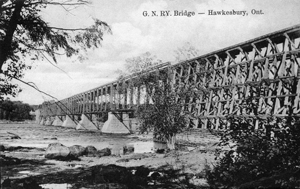Great Northern Railway of Canada Reporting mark: unknown
The Great Northern Railway of Canada (not to be confused with Great Northern Railway in the US) was a short-lived regional line that operated from 1892 to 1907. It was built to provide service from the Rivière-à-Pierre (about halfway between Grand-Mère, Quebec and Quebec City) to Hawkesbury, Ontario.
The railway was never intended to be more than a small branch line. The prospectus called for the construction of only 110 miles (177 km) of railway, specifically those sections running from Saint-Tite to Sainte-Julienne (75 miles or 121 km) and Saint-Jérôme to Grenville, along with a bridge over the Ottawa River to Hawkesbury (35 miles or 56 km). The remainder would be handled by interconnections with other small branch lines, in particular the Quebec and Lake St. John Railway, and the Lower Laurentian Railway. Once in Hawkesbury, the railway would connect with the Canada Atlantic Railway (CAR) which had a direct link to the harbours in the Parry Sound area, in Depot Harbour, on the Georgian Bay.

Hawkesbury, Ontario, ca. 1905
The prospectus extolled the distinct advantages for Quebec, primarily the Quebec lumber industry. By utilizing the CAR, rather than the much longer lake route through Buffalo to Duluth, shipments could go directly from the Georgian Bay to Duluth, thus shaving approximately 800 miles (1287 km) off the journey. This would translate into a considerable cost advantage for the Quebec lumber industry along with the added opportunity of being able to ship increased volumes. On paper the plan looked sound. The company was capitalized to the tune of $3 million in stock.
The company's board of directors was comprised of seven individuals, mainly from the Quebec business and political communities. Two had somewhat questionable backgrounds.
The first was John Eno, an American taking refuge in Canada after being accused of defalcation, a form of embezzlement. It seems that while serving as president of the Second National Bank, Eno helped himself to almost $4 million to cover his losses in the stock market. While Eno's wealthy father was busy bailing out the bank, Eno fled to Canada where he was able to avoid extradition back to the US.
Eno eventually returned to the US in 1893 after a nine-year absence. Enough time had elapsed for the indictments against him to be quashed thereby allowing him to escape prosecution. Eno spent the remainder of his life frittering away the balance of his family's fortune, dying penniless and in debt in 1916.
Also on the Board of Directors was Pierre Garneau, a provincial politician and former provincial treasurer, who had been involved in the Baie des Chaleurs Railway scandal. The scandal involved a $175,000 payout on a damages claim to railway contractor Charles Newhouse Armstrong, after he was excluded from the Baie des Chaleurs Railway Company. Armstrong did not profit quite as handsomely as some supposed. As it turned out $100,000 of the settlement found its way into the hands of Ernest Pacaud, a fund-raiser and back-room boy for the provincial Liberal Party. As treasurer, Garneau's signature was on the cheque.
A subsequent inquiry concluded Garneau had used poor judgment and failed to exercise due diligence but absolved him of any wrongdoing. Garneau remained in provincial politics until 1904 and passed away the following year.
Last but never least was the aforementioned Charles Newhouse Armstrong, who managed to get himself hired as a contractor and promoter. Armstrong had already built a rather dubious (some would say shady) reputation for himself as a railway promoter.
The railway was finally completed in 1900. Despite its rather shaky start, photos from the period show a group of attractively designed stations, a well-built infrastructure and an emphasis on tourism. A handsome 132-page guidebook, filled with photos, offered profiles of each of the communities along the route.
In 1903, the company purchased the bankrupt Montfort and Gatineau Railway, which in all likelihood it could ill afford. By 1906 the railway was out of money. Luckily for the investors, Armstrong managed to pull one more rabbit out of his hat and sell the fledgling line to Mackenzie and Mann, owners of the Canadian Northern Railway (CNoR). The CNoR took over in 1907.
The CNoR was in the process of a massive expansion and the purchase fitted in well with their plans. The railway was promptly merged with several other railways to form the Canadian Northern Quebec Railway Company (CNoRQ). This provided the CNoR with a line running from the Ottawa River directly to the St. Lawrence River in Quebec. Further extensions and changes were added over the next few years as the CNoR was extended to Montreal. The railway remained in the CNoR's hands until 1918, when it fell to bankruptcy and became part of Canadian National Railways (CN).
